|
|
|
|
1910–1924 | 1925–1926 | 1927–1930 | 1931–1943 | MORE RECENT
|
THE NEW YORK TIMES • June 24, 1928 • Page IV, 13; Column –
|
HOUDINI LIVED TO SEE HIS NAME A SYNONYM FOR ESCAPE
Mr. Kellock’s Biography of the Late Magician Recounts the Mystifying Stunts by Which He Became Known as “The Handcuff King”
HOUDNI. His Life Story. By Harold Kellock. From the Recollections and Documents of Beatrice Houdini, 384 pp. Illustrated. New York: Harcourt, Brace & Co. $3.75
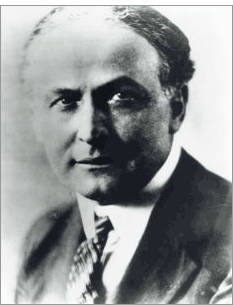 a hundred Years from now, when they read of Houdini’s exploits, men will probably conclude that this generation was unduly credulous or easily deceived. Nobody could possibly do the things that Houdini did. Yet test after test was made of his power to escape from any physical predicament, and reliable and skeptical witnesses can vouch for every instance. He could be buried alive, manacled, straitjacketed, buried into the sea in a sealed casket, laced up in a cocoon of strong silk fishing line, strapped to a cot with wet bandages, enclosed in barrels, safes, leather footballs, paper bags and even the belly of a dead whale, and make his escape without leaving a trace of how he got out. He could make a five-ton elephant vanish form the stage of the New York Hippodrome, and when asked for the secret would reply: “Even the elephant does not know how it is done.” He would walk into a prison and let the wardens strip him, manacle him and leave him in their strongest cell, and he would be out, dressed and jaunty, in a few minutes. a hundred Years from now, when they read of Houdini’s exploits, men will probably conclude that this generation was unduly credulous or easily deceived. Nobody could possibly do the things that Houdini did. Yet test after test was made of his power to escape from any physical predicament, and reliable and skeptical witnesses can vouch for every instance. He could be buried alive, manacled, straitjacketed, buried into the sea in a sealed casket, laced up in a cocoon of strong silk fishing line, strapped to a cot with wet bandages, enclosed in barrels, safes, leather footballs, paper bags and even the belly of a dead whale, and make his escape without leaving a trace of how he got out. He could make a five-ton elephant vanish form the stage of the New York Hippodrome, and when asked for the secret would reply: “Even the elephant does not know how it is done.” He would walk into a prison and let the wardens strip him, manacle him and leave him in their strongest cell, and he would be out, dressed and jaunty, in a few minutes.
Nobody knows how he did it. He told no one his secret, not even his wife. He maintained stoutly that it was all explainable by purely physical means, that there was nothing supernatural in his bag of tricks. Sir Arthur Conan Doyle refused to be convinced, even by Houdini, maintaining that, unknown to himself, the latter possessed strange psychic powers. This Houdini denied. Part of his secret we do know. He never let himself become afraid. He was in perfect physical condition and had trained every one of his muscles to respond to his wishes so that he could tie and untie complicated knots with his toe [sic]. He could hold his breath under water for four minutes, and once remained in a submerged sealed casket for over an hour and a half. That his secret was purely physical was evidenced by the bruised and exhausted condition in which he emerged from some of his more rigorous tests. He was no charlatan, and hundreds and thousands of people alive today have seen him perform his miracles of evasion.
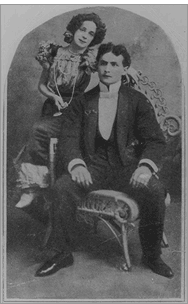 Mr. Kellock has chosen to write the life of this strange genius, one of the most extraordinary mixtures of childish vanity and uncanny skill that the world has ever seen. Houdini’s real name was Ehrich Weiss. He was born at Appleton, Wis., on April 6, 1874, the son of Rabbi Mayer Samuel and Cecilia Weiss, of Jewish blood and faith, originally from Hungary. From an early age he specialized in locks, beginning with that of his mother’s jam closet, until in later years it seemed that all he had to do was to pass his hands over a lock for it to spring open. He adapted the name of Houdini in admiration of the French magician, Robert-Houdin, who early aroused young Houdini’s enthusiasm for the art of [illusion?]. Later, when he [studied the facts?] about Robert-Houdin, and discovered that the [?] was a charlatan, in his anger he wrote a book exposing him; but by that time Houdini had become the synonym for escape and he never dropped the [?]. Mr. Kellock has chosen to write the life of this strange genius, one of the most extraordinary mixtures of childish vanity and uncanny skill that the world has ever seen. Houdini’s real name was Ehrich Weiss. He was born at Appleton, Wis., on April 6, 1874, the son of Rabbi Mayer Samuel and Cecilia Weiss, of Jewish blood and faith, originally from Hungary. From an early age he specialized in locks, beginning with that of his mother’s jam closet, until in later years it seemed that all he had to do was to pass his hands over a lock for it to spring open. He adapted the name of Houdini in admiration of the French magician, Robert-Houdin, who early aroused young Houdini’s enthusiasm for the art of [illusion?]. Later, when he [studied the facts?] about Robert-Houdin, and discovered that the [?] was a charlatan, in his anger he wrote a book exposing him; but by that time Houdini had become the synonym for escape and he never dropped the [?].
His career was, of course, utterly impossible. He began with odd jobs at circuses and side-shows at Coney Island, where he met his wife at one of his performances (he ruined her dress by accident as she was sitting in the front row of spectators) and married her out of hand. The Houdinis went on the road with various circuses and other shows, got a job with Tony Pastor, and were finally taken up by Martin Beck. Under Beck he learned to concentrate on his special tricks, the handcuff act and his trunk act, out of which grew all the legions of almost legendary evasions. He went on tour in Europe, enjoying an uninterrupted series of successes. In 1913 his beloved mother died and he returned to America a changed and despondent man. He became fascinated by graveyards, insane asylums and prisons. Toward the end of his life he concentrated on the exposure of mediums and spiritualists, exposing fakes throughout the country and showing people how they were fooled. He died in 1926 at Detroit of peritonitis, after he had insisted on going through a performance with a ruptured appendix.
Mr. Kellock has telescoped this amazing life into his opening paragraph, which sets down substantially the man’s relation to his age:
Houdini began his career with a traveling circus at the age of 9, in the Middle West, and his first trick, which he had perfected laboriously in secret in the family woodshed, was to pick up needles with his eyelids while suspended by the heels, head downward. From this humble early beginning it was a far cry, and for many years a laborious struggle, to the role of the master magician who thrilled and amazed great audiences everywhere with his daredevil feats, his unsurpassed dexterity, his almost superhuman physical endurance, his mystifying escapes from manacles, straitjackets, prison cells, sealed chambers, chests and casks of every kind, from his famous Chinese water-torture cell, from a living grave six feet in the earth and from a heavy packing case, carefully nailed together by experts, weighted and tossed into the sea. When he died, in Detroit, Oct. 31, 1926, at the age of 52, he had been a public performer for forty-three years.
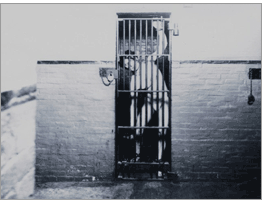 No prison could hold him and no one ever detected him in the act of escape. The only people who ever witnessed his actual manoeuvres [sic] in freeing himself from handcuffs were a German judge and jury who were trying his libel suit against a police official who had called him an impostor. His movements were so rapid that the eye could not follow them. Among the evasions for which Houdini was famous, this is typical: No prison could hold him and no one ever detected him in the act of escape. The only people who ever witnessed his actual manoeuvres [sic] in freeing himself from handcuffs were a German judge and jury who were trying his libel suit against a police official who had called him an impostor. His movements were so rapid that the eye could not follow them. Among the evasions for which Houdini was famous, this is typical:
In Boston, Superintendent of Police William H. Pierce locked him in a second-tier cell of the city jail, after he had been stripped, searched, manacled and leg-ironed, and locked his clothes in a cell in the first tier, in another section of the prison. Twenty-three minutes later Houdini called Superintendent Pierce on the telephone from Keith’s Theatre, some distance away. He had stepped out of his cell, [?] his clothes, [?] up to the third tier and released a prisoner, whom he locked in his own second-tier cell, [?] himself through two steel doors [into] the prison yard, climbed the wall and jumped into a waiting automobile, [?] was [?] the wall [?] [?] after he had been locked up, and the drive to the theatre took seven minutes.
Another [?] and mystifying stunt was his Can Escape.
This trick was an escape from a galvanized iron can, filled with twenty-two large pailfuls of water, with its lid fastened on by a dozen or more heavy outside padlocks. Enclosed in the can and rolled into his little tent after a committee had assured itself that aid from hidden confederates was impossible, Houdini would spirit himself out in about a minute, leaving the can filled to the brim and all the locks intact.
This led to innumerable variants. At Shepherd’s Bush, in England, he was coopered in a rum-punch barrel. “He was out in forty seconds, leaving the barrel intact.” At Salt Lake City he was screwed in a coffin and locked in a steel burial vault. He was out in short order. In the presence of New York newspaper reporters he submitted to the following process:
They were enlisted to put the irons on Houdini. Then he insisted that they superintend the nailing up of the box (it was a stout packing case containing 200 pounds of lead). After the cover was hammered down, a steel band was fastened about the box for good measure. Then it was roped and allowed to slide down a chute into the waters of the bay, where it floated almost wholly submerged at the end of 100 feet of line.
At the end of fifty-seven seconds there was a splash beside the box and Houdini bobbed into view. He swam to the tug, and the box was hauled in after him. It was intact. The nails and the steel bands were still in place. The cover was then pried off and there at the bottom lay the handcuffs and leg-irons. Their locks had been sprung open, and they were in good working order.
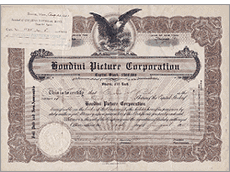 In his later years Houdini became rather overbearing. He was almost insane on the subject of publicity and would resort to anything—save smut, which he abhorred—to obtain it. He nourished a monstrous egotism, which induced him to start the Houdini Picture Corporation, “in which he was to serve as manager, author, editor, caption writer, supervisory director and star.” The venture failed. He wrote short stories. “Most of them,” says Mr. Kellock, “were romantic fairy tales, showing no little imagination, in which strong men and magicians [?] in plots of impeccable morality.” He behaved with preposterous assurance before a Congressional committee, which was considering legislation to [curb?] the mediums of the District of Columbia. He had little sense of humor and could not stand ridicule. Mr. Kellock recounts this revealing incident: In his later years Houdini became rather overbearing. He was almost insane on the subject of publicity and would resort to anything—save smut, which he abhorred—to obtain it. He nourished a monstrous egotism, which induced him to start the Houdini Picture Corporation, “in which he was to serve as manager, author, editor, caption writer, supervisory director and star.” The venture failed. He wrote short stories. “Most of them,” says Mr. Kellock, “were romantic fairy tales, showing no little imagination, in which strong men and magicians [?] in plots of impeccable morality.” He behaved with preposterous assurance before a Congressional committee, which was considering legislation to [curb?] the mediums of the District of Columbia. He had little sense of humor and could not stand ridicule. Mr. Kellock recounts this revealing incident:
At Houdini’s last benefit performance, that of the Jewish Federation, at the Polo Grounds in New York, a few weeks before his death, he *** found himself confronted by the jocose Loney Haskell as master of ceremonies. *** Haskell waited until Houdini was being tied up in a straitjacket, whereupon he started a satirical introduction, asserting that Houdini could not escape from a Gus Sun contract or from the traffic jam at Forty-second Street and Broadway. He was proceeding merrily, all at Houdini’s expense, when he was stopped by a tremendous kick in the shins. Houdini, tied up, had wriggled half way across the stage to administer that kick. Red-faced with anger, he lay at Haskell’s feet, glaring up at him. “No, no!” he whispered savagely. “No comedy.” Haskell limped into the wings to see if his ankle was broken. As soon as the act was over Houdini rushed to him, all contrition and apologies: “I just can’t stand comedy, Lon,” he kept repeating.
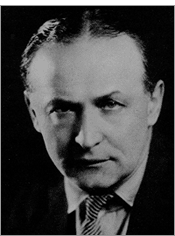 Houdini took himself and his gifts immensely seriously. He was childishly extravagant and given to violent fits of temper. He was charitable, kind to friends, relatives and needy members of his profession. His marriage was a happy one, and yet he could be aroused to frantic fits of jealousy by trifles. The book gives a charming picture of his relations with his wife, Bess, and with his mother. He had many acquaintances but few friends. He was at his best behind the footlights or in a glare of publicity, with every eye fixed on him and rounds of applause rewarding his consummate skill. He developed from a public entertainer to a public institution and almost to a public nuisance. He showed the world that a man could escape from any man-made trap, but he refused to tell the world how to do it. He carried his secrets with him to the grave, for he believed that his knowledge was too dangerous to be entrusted to the general public. In this the police officials of the world would probably agree. Houdini took himself and his gifts immensely seriously. He was childishly extravagant and given to violent fits of temper. He was charitable, kind to friends, relatives and needy members of his profession. His marriage was a happy one, and yet he could be aroused to frantic fits of jealousy by trifles. The book gives a charming picture of his relations with his wife, Bess, and with his mother. He had many acquaintances but few friends. He was at his best behind the footlights or in a glare of publicity, with every eye fixed on him and rounds of applause rewarding his consummate skill. He developed from a public entertainer to a public institution and almost to a public nuisance. He showed the world that a man could escape from any man-made trap, but he refused to tell the world how to do it. He carried his secrets with him to the grave, for he believed that his knowledge was too dangerous to be entrusted to the general public. In this the police officials of the world would probably agree.
Mr. Kellock’s book is a pleasant official biography. He has naturally addressed the kindlier side of Houdini’s character in dealing with material supplied by the latter’s widow. He has edited a great mass of extraordinary evidence with skill and assurance. At the end Houdini emerges as a strange blend of conceit and high ability, kindliness and childishness, pomposity and generosity. One wonders, however, whether a later generation will take the word of those now alive for the facts of the career of little Ehrich Weiss, who became the great “Houdini, the Handcuff King.”
This article is reproduced here only for educational purposes. Please do not copy the text or accompanying images for commercial use.
HOME • ABOUT • ARTICLES • LINKS
Back to Top
|
|


 Mr. Kellock has chosen to write the life of this strange genius, one of the most extraordinary mixtures of childish vanity and uncanny skill that the world has ever seen. Houdini’s real name was Ehrich Weiss. He was born at Appleton, Wis., on April 6, 1874, the son of Rabbi Mayer Samuel and Cecilia Weiss, of Jewish blood and faith, originally from Hungary. From an early age he specialized in locks, beginning with that of his mother’s jam closet, until in later years it seemed that all he had to do was to pass his hands over a lock for it to spring open. He adapted the name of Houdini in admiration of the French magician, Robert-Houdin, who early aroused young Houdini’s enthusiasm for the art of [illusion?]. Later, when he [studied the facts?] about Robert-Houdin, and discovered that the [?] was a charlatan, in his anger he wrote a book exposing him; but by that time Houdini had become the synonym for escape and he never dropped the [?].
Mr. Kellock has chosen to write the life of this strange genius, one of the most extraordinary mixtures of childish vanity and uncanny skill that the world has ever seen. Houdini’s real name was Ehrich Weiss. He was born at Appleton, Wis., on April 6, 1874, the son of Rabbi Mayer Samuel and Cecilia Weiss, of Jewish blood and faith, originally from Hungary. From an early age he specialized in locks, beginning with that of his mother’s jam closet, until in later years it seemed that all he had to do was to pass his hands over a lock for it to spring open. He adapted the name of Houdini in admiration of the French magician, Robert-Houdin, who early aroused young Houdini’s enthusiasm for the art of [illusion?]. Later, when he [studied the facts?] about Robert-Houdin, and discovered that the [?] was a charlatan, in his anger he wrote a book exposing him; but by that time Houdini had become the synonym for escape and he never dropped the [?].
 No prison could hold him and no one ever detected him in the act of escape. The only people who ever witnessed his actual manoeuvres [sic] in freeing himself from handcuffs were a German judge and jury who were trying his libel suit against a police official who had called him an impostor. His movements were so rapid that the eye could not follow them. Among the evasions for which Houdini was famous, this is typical:
No prison could hold him and no one ever detected him in the act of escape. The only people who ever witnessed his actual manoeuvres [sic] in freeing himself from handcuffs were a German judge and jury who were trying his libel suit against a police official who had called him an impostor. His movements were so rapid that the eye could not follow them. Among the evasions for which Houdini was famous, this is typical:
 In his later years Houdini became rather overbearing. He was almost insane on the subject of publicity and would resort to anything—save smut, which he abhorred—to obtain it. He nourished a monstrous egotism, which induced him to start the Houdini Picture Corporation, “in which he was to serve as manager, author, editor, caption writer, supervisory director and star.” The venture failed. He wrote short stories. “Most of them,” says Mr. Kellock, “were romantic fairy tales, showing no little imagination, in which strong men and magicians [?] in plots of impeccable morality.” He behaved with preposterous assurance before a Congressional committee, which was considering legislation to [curb?] the mediums of the District of Columbia. He had little sense of humor and could not stand ridicule. Mr. Kellock recounts this revealing incident:
In his later years Houdini became rather overbearing. He was almost insane on the subject of publicity and would resort to anything—save smut, which he abhorred—to obtain it. He nourished a monstrous egotism, which induced him to start the Houdini Picture Corporation, “in which he was to serve as manager, author, editor, caption writer, supervisory director and star.” The venture failed. He wrote short stories. “Most of them,” says Mr. Kellock, “were romantic fairy tales, showing no little imagination, in which strong men and magicians [?] in plots of impeccable morality.” He behaved with preposterous assurance before a Congressional committee, which was considering legislation to [curb?] the mediums of the District of Columbia. He had little sense of humor and could not stand ridicule. Mr. Kellock recounts this revealing incident:
 Houdini took himself and his gifts immensely seriously. He was childishly extravagant and given to violent fits of temper. He was charitable, kind to friends, relatives and needy members of his profession. His marriage was a happy one, and yet he could be aroused to frantic fits of jealousy by trifles. The book gives a charming picture of his relations with his wife, Bess, and with his mother. He had many acquaintances but few friends. He was at his best behind the footlights or in a glare of publicity, with every eye fixed on him and rounds of applause rewarding his consummate skill. He developed from a public entertainer to a public institution and almost to a public nuisance. He showed the world that a man could escape from any man-made trap, but he refused to tell the world how to do it. He carried his secrets with him to the grave, for he believed that his knowledge was too dangerous to be entrusted to the general public. In this the police officials of the world would probably agree.
Houdini took himself and his gifts immensely seriously. He was childishly extravagant and given to violent fits of temper. He was charitable, kind to friends, relatives and needy members of his profession. His marriage was a happy one, and yet he could be aroused to frantic fits of jealousy by trifles. The book gives a charming picture of his relations with his wife, Bess, and with his mother. He had many acquaintances but few friends. He was at his best behind the footlights or in a glare of publicity, with every eye fixed on him and rounds of applause rewarding his consummate skill. He developed from a public entertainer to a public institution and almost to a public nuisance. He showed the world that a man could escape from any man-made trap, but he refused to tell the world how to do it. He carried his secrets with him to the grave, for he believed that his knowledge was too dangerous to be entrusted to the general public. In this the police officials of the world would probably agree.